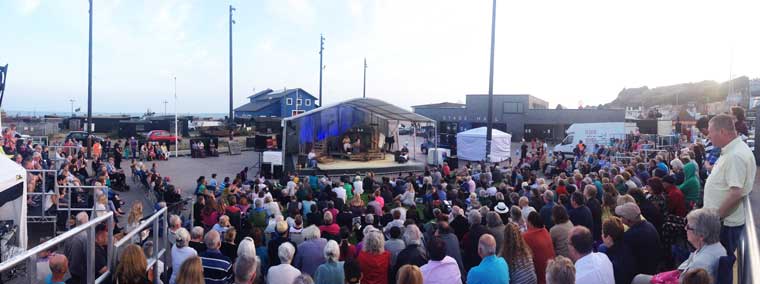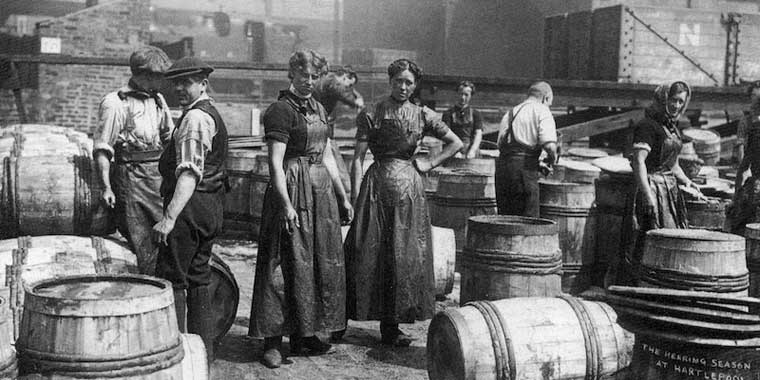Hard times
A moving story of Scotland’s herring lasses set against the backdrop of the 1881 Eyemouth disaster, which claimed the lives of 129 fishermen and boys, Get Up & Tie Your Fingers finished its latest tour with a triumphant performance on Hastings Stade.
Get Up & Tie Your Fingers has become something of an institution. The first play written by Ann Coburn, who has gone on to write a string of others along with 12 books, it premiered at the Borders Festival in 1995. A successful stint at the Edinburgh Festival followed and it has toured most years ever since, adding an evocative choral score along the way, composed by Karen Wimhurst. The latest tour ended last Friday with a moving outdoor performance on Hastings Stade, an ideal location with the fishing boats and lifeboat station in clear view just beyond the stage, and herring gulls cawing in the evening sky overhead.
The play focuses on Scotland’s east coast herring lasses who worked in teams, or “crews”, of three, gutting, salting and packing in barrels the fish plucked from the huge shoals that journeyed round our coastline. “‘Get up and tie your fingers’ was the traditional cry of the caller, sent from the curing yards to rouse the gutting crews from their beds when the fleet came in,” explains Ann Coburn in the play’s programme. “The crew members had to tie their fingers with strops of cloth as protection against the gutting knives and the pickling salt.”
The play is built around the Eyemouth disaster of 14 October 1881, when 129 men and boys were lost in a sudden and savage storm. Of 45 boats that set out from the harbour, only 25 returned. “Many of the family-run, six-man boats tried to get back into the harbour, but were swept past its mouth on to the rocks in the bay,” writes Ann. “Women and children were close enough to watch their menfolk drown but had no hope of reaching them.”
This tour was called Follow the Herring, taking the same route as the “army of Scotswomen” who followed the shoals’ migration south, stopping at such traditional herring ports as South Shields, Grimsby, Great Yarmouth and finally Hastings. “Fishwives and herring lasses were strong, resilient women with financial independence and an equal partnership with their men,” writes Ann. “Herring lasses travelled freely and independently at a time when many women lived restricted lives.”
There’s a terrific account of what the work was like in East Anglia on the BBC‘s history website (click here to read). “When Great Yarmouth’s herring industry was at its peak in the early 1900s, 10,000 seasonal workers were welcomed into the town – of that number 5,000 were Scotswomen. When the women arrived at their destinations they were committed to working long, uncomfortable hours, often from 7am until 9pm, or whenever the day’s catch had been dealt with.”
One eyewitness recalls the quayside settings: “It was much harder work in Yarmouth and Lowestoft because it was autumn and into winter. The curing yards weren’t covered. They had no protection overhead so [the girls] had to work in the open with the haar coming off the river, the icy sleet coming in off the North Sea, fog rolling in and gales of wind. Sometimes the women would actually faint with the cold.”
That peripatetic way of life continued into the 1960s until over-fishing devastated the herring shoals, leaving the gutters with little to do. Political pressures prevented any real action from being taken to redress the crisis in stocks, until finally a ban on industrial fishing for herring in the North Sea was introduced in 1975, extended to a complete ban on all fishing for herring in the North Sea and English Channel in February 1977. Stocks recovered somewhat as a result and selective fishing was reintroduced in 1981 and has been strictly regulated since. Now the (very different) herring fisheries in the Scottish North Sea and Hastings are sustainably managed and MSC-certified. (Look out for more on herring fishing in Scotland in a few weeks.)
Although set in Eyemouth, this production of Get Up & Tie Your Fingers was carefully grounded in the places it performed by the inclusion of a local choir with the professional cast at each stop. The Hastings performance was particularly special, not only because it was the last and the only one to take place outside, but also because many members of the choirs from along the tour were in the audience. They all joined in for the final song, so that suddenly voices came from all directions. When the play finished, they were called up to the stage to take a final bow en masse and to perform a rousing encore. It was quite a moment and a fitting end to the latest incarnation of this deservedly enduring play.








